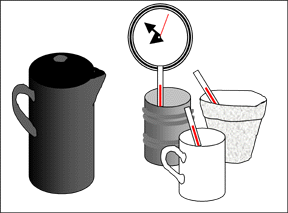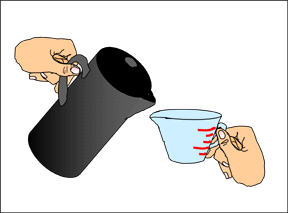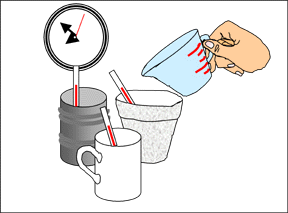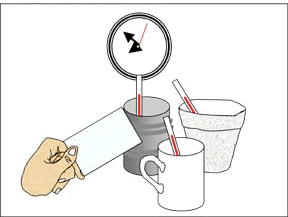Contributed by: Third International Math and Science Study (TIMSS)
Description:
Student investigates the effect of different container materials on
heat transfer; draws a conclusion about the best insulator; and applies
concept to a new, seemingly quite different problem.
Students are given three containers of different insulating capacity,
for example, metal, ceramic, and plastic, and are asked to find
out which one would keep a hot drink warm for the longest time.
They also receive thermometers, a clock, a piece of card to use
as a fan, and a supply of hot water. The students are instructed
to pour a measure of hot water into each of the containers, and
to take the temperature in each one over a ten-minute interval.
They are provided with a pre-designed data table in which to record
their observations. This task assesses students' abilities to make
and record measurements of temperature and probes their understanding
of the concept of insulation.
This task is designed to take students approximately 20 to 30
minutes to complete.
Overall Task Content Area:
-
- Physical Science
Specific Knowledge Areas:
-
- Physical Properties of Matter
-
- Heat Transfer
Performance Expectations:
- conducting investigations
- using equipment
- gathering, organizing, and representing data
- formulating conclusions from investigational data
- applying scientific principles to develop explanations and solve
new problems
National Science Education Standards:
4 B PS 1: Properties of objects and materials: Grades
K-4
1.1 Objects have many observable properties, including
size, weight, shape, color, temperature, and the ability to react
with other substances. Those properties can be measured using tools,
such as rulers, balances, and thermometers.
4 B PS 3: Light, heat, electricity, and magnetism: Grades
K-4
3.2 Heat can be produced in many ways, such as burning, rubbing,
or mixing one substance with another. Heat can move from one object
to another by conduction.
4 A SI 1: Ability to do scientific inquiry: Grades K-4
1.3 Employ simple equipment and tools to gather data and
extend the senses. In early years, students develop simple skills,
such as how to observe, measure, cut, connect, switch, turn on and
off, pour, hold, tie, and hook. Beginning with simple instruments,
students can use rulers to measure the length, height, and depth
of objects and materials; thermometers to measure temperature; watches
to measure time; beam balances and spring scales to measure weight
and force; magnifiers to observe objects and organisms; and microscopes
to observe the finer details of plants, animals, rocks, and other
materials. Children also develop skills in the use of computers
and calculators for conducting investigations.
1.4 Use data to construct a reasonable explanation. This
aspect of the standard emphasizes the studentsí thinking as they
use data to formulate explanations. Even at the earliest grade levels,
students should learn what constitutes evidence and judge the merits
or strength of the data and information that will be used to make
explanations. After students propose an explanation, they will appeal
to the knowledge and evidence they obtained to support their explanations.
Students should check their explanations against scientific knowledge,
experiences, and observations of others.
(Use the "hot" link on the PALS home
page to check the full text of related National Science Education
Standards, if desired.)
National Council of Teachers of Mathematics:
AL4: Analyze change in various contexts:
Grades pre K-5 b. describe quantitative change, such as a student’s
growing two inches in one year
DAP1: Formulate questions that can
be addressed with data and collect, organize, and display relevant
data to answer them:
Grades pre K-5 e. collect data using observations,
surveys, and experiments
MEAS1: Understand measurable attributes of objects and
the units, systems, and processes of measurement:
Grades pre K-5 a. recognize the attributes of length, volume,
weight, area, and time
Grades pre K-5 b. compare and order objects according to these
(length, volume, weight, area, and time) attributes
MEAS2: Apply appropriate techniques, tools, and formulas
to determine measurements:
Grades pre K-5 c. use tools to measure
RP3: Develop and evaluate mathematical arguments and
proofs:
Grades pre K-5
Materials for "Containers":
At this station students should have:
-
- -Three containers (or cups) marked A, B, C
- Three thermometers
- A clock or watch
- A container with very hot water
- Pieces of card to use as a fan, if desired
- A roll of paper to wipe up spills
- A measuring cup
Advance Preparation
A supply of very hot water must be prepared ahead of time and
a procedure established for students to safely access and use the
supply.
Station Setup: Check that all of the equipment
listed below is provided.
| 3 containers |
The containers must be approximately the same size and shape.
They should each be made from a different material and must
give measurable differences in cooling rates. One ceramic, one
metal, and one paper or Styrofoam (such as disposable coffee
cups) are recommended. A metal can of approximately the same
volume as the other containers with the top cut out may be used
as one of the containers. Label the containers A, B,
and C. On Form PA1, provide a description of the 3 containers
for the coder, as well as your own findings as to the differences
in the rates of cooling and any variation in volume of the three
containers. |
| 3 thermometers |
Standard Celsius thermometers, approximately 10oC
to 110oC. They should be identical, and they should
be pretested together in a container of water to ensure that
they agree. If these are unavailable, be sure the thermometer
used can be read to a degree (estimates to 0.5 degrees). Administrators
must make sure students know whether the thermometer is calibrated
in Fahrenheit or Celsius degrees.
For safety and improved accuracy, the administrator may
wish to support the thermometers by fastening them to a stand
or some other support. Since the students' later readings
are compared only with their own earlier ones, whether or
not the thermometer touches the container does not significantly
affect results on the task. Administrators and NRCs will determine
the safest and most trouble free set up, given their equipment.
|
| Hot water |
A source of hot water is required. Best results are obtained
if you use near boiling water. In this case, for safety reasons,
pour the waste yourself into the containers for students at
this station when they are ready to begin. You may also wish
to stabilize the containers by placing all 3 in a box or pan
with low sides, in case hot water is spilled. The experiment
will not yield results if the starting temperature is close
to room temperature. |
| Clock or watch |
Provide students with a watch or call their attention to the
wall clock. It is preferable, but not necessary, that the watch
measure time in seconds. A stop watch is not desirable but may
be used if the students are instructed to use it merely as a
watch and not stop it at each measurement. |
| Measuring cup |
6 or 8 oz measuring cup should be provided if the containers
provided are not calibrated. |
| Pieces of card |
Pieces of card, about 3 x 5 in (7 x 12 cm) or slightly larger
are suitable. Students may or may not choose to use them as
a fan. |
| Towels |
Paper or cloth to wipe up spills and to wipe out the beakers
when the activity is completed. |
| Booklets |
A student booklet for each student that will perform this
task. |
Note: One of the things this task measures is student ability
to read the thermometer, but the entire task need not be failed
because of a lack of this skill. If the thermometer itself has any
peculiarities, such as being calibrated in both Celsius and Fahrenheit,
you will have pointed this out to all students before the testing
sessions begins.
However, if an individual student is making gross errors in handling
the thermometer, such as putting it in the liquid upside down, after
3 to 4 minutes you may intervene. Indicate on the student booklet
that the student could not obtain measurements without assistance,
and cite exactly what kind of assistance was given. This will allow
the student to proceed with later questions in the task, and allow
the coder to record the lack of skill with the equipment.
Note that assistance is only provided if the student decides to
measure temperature and cannot use the equipment, not if she or
he simply touches the containers and records "hot, cold,..." Do
not provide any instructions about measuring volume. It may or may
not occur to some students that volume is a variable that could
be measured or controlled. Do not provide any assistance if the
student is using the equipment correctly but is not able to read
the thermometer.
Safety:
- Be careful.
- Teachers and students should always exercise appropriate safety
precautions and utilize appropriate laboratory safety procedures
and equipment when working on science performance tasks.
Extensions/modifications:
- Rubric language should be expanded and targeted to the specific
NCTM standard(s) to be measured.
Advanced Preparation Set Up:
| Teacher: 1) Prepare very hot water
at student workstation. |
2) Assist student with hot water
if necessary. |
 |
 |
| |
|
| Student: 1) Pour hot water into containers
and perform experiment. |
2) Use index card as fan if desired. |
 |
 |
|





